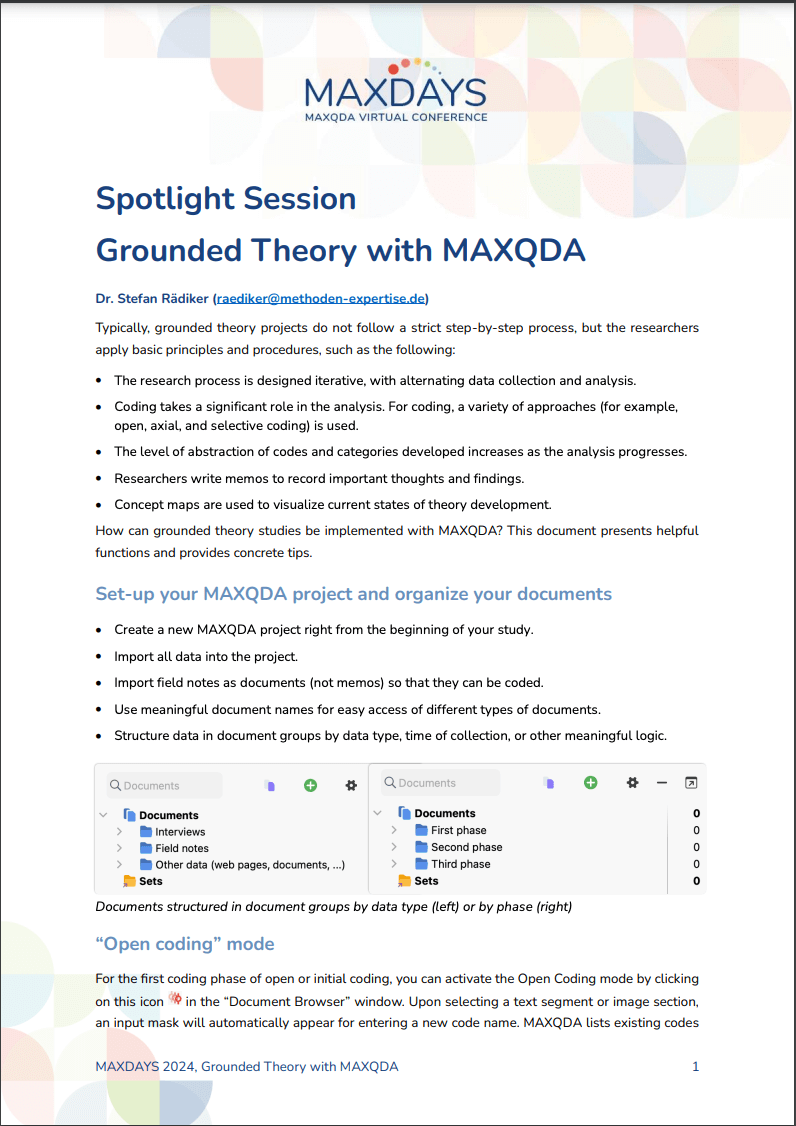Last updated: 09.01.2025
The Grounded Theory approach ranks among the most important analytical methods in qualitative social research, offering a structured framework for systematic data analysis.
This research guide will show you how to quickly and effectively get started with the Grounded Theory method and implement it in your research—all supported by MAXQDA analysis software.
Using MAXQDA, you’ll be able to:
- Systematically organize and analyze your data
- Develop codes and categories
- Create and manage memos
- Visually map theoretical relationships
- Document and publish your findings
Additionally, at the end of this article, you’ll discover how to meaningfully enhance your Grounded Theory analysis through artificial intelligence integration—using AI Assist, MAXQDA’s AI tool.

What is Grounded Theory?
Grounded Theory is a research approach for systematically developing a substantive theory that is grounded in the collected data. Unlike hypothesis-testing methods, the Grounded Theory method doesn’t begin with a predetermined theory but instead develops theoretical concepts inductively from the empirical material.
The foundations of Grounded Theory were established in 1967 by sociologists Barney Glaser and Anselm Strauss in their book The Discovery of Grounded Theory. In this work, they introduced the first systematic approach to developing theory directly from data. Over time, several variants have emerged from this original approach: Glaser’s classical approach (1978), Strauss & Corbin’s pragmatic advancement (1990), Charmaz’s constructivist approach (2006), and Clarke’s postmodern situational analysis (2005). While these approaches differ in their fundamental assumptions, they all share the central principle of data-based theory development.
A distinctive characteristic of the Grounded Theory approach lies in its iterative-cyclical research process: data collection, analysis, and theory development often don’t occur in linear succession but rather in continuous interplay. This process is guided by “Theoretical Sampling“ — the deliberate selection of additional data based on emerging theoretical concepts.
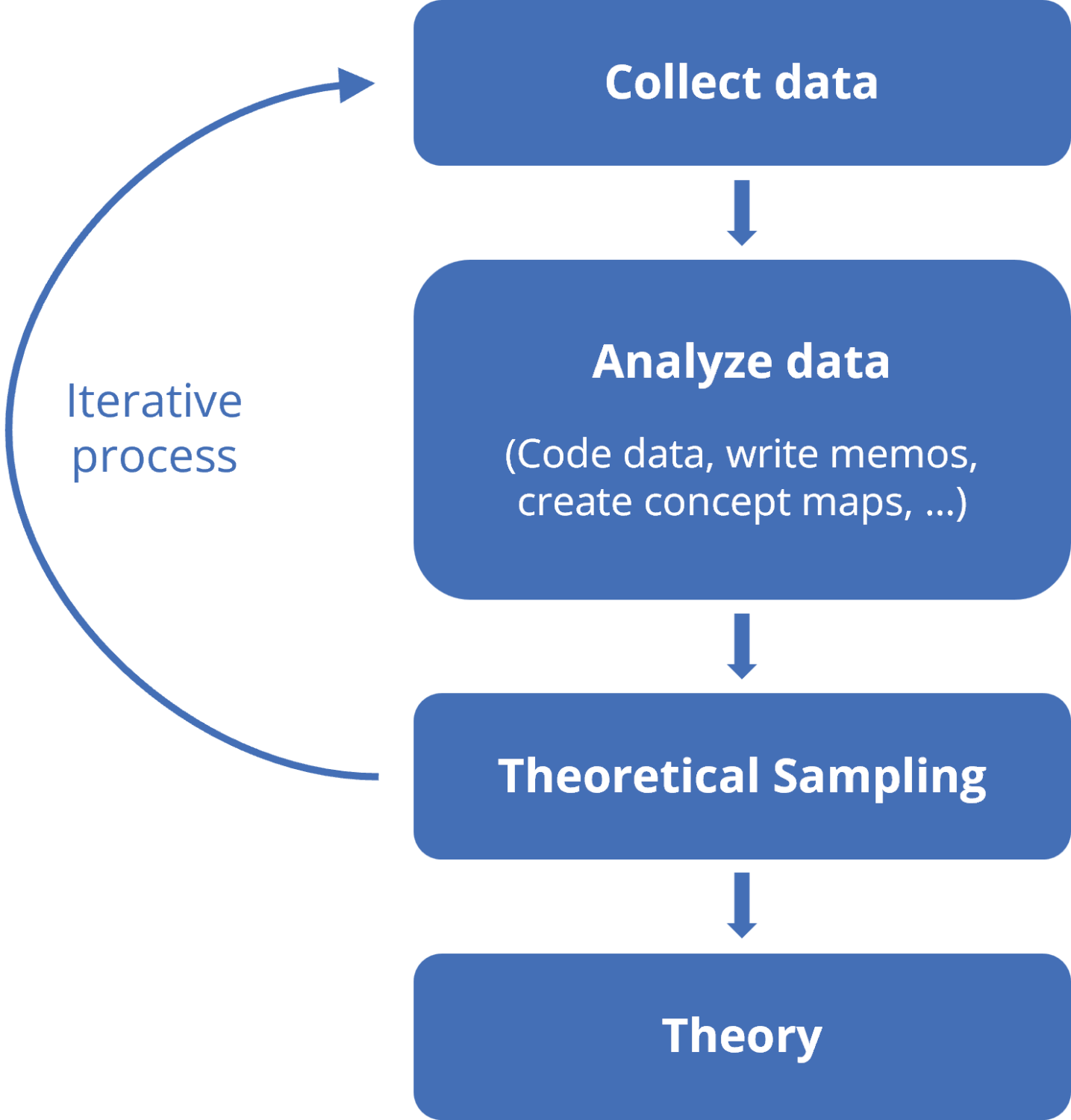
Simplified Flow of a Grounded Theory Study
“All is data”—this well-known principle from Barney Glaser emphasizes that diverse types of data can be incorporated into the analysis: interviews, observation protocols, documents, photographs and images, audio and video materials. MAXQDA supports you in integrating and systematically analyzing all these data types.
Grounded Theory Analysis with MAXQDA
The Grounded Theory approach is distinguished by its methodological flexibility—there are no rigid rules or strictly prescribed analytical steps. Nevertheless, the research process can be organized into four characteristic working stages:
- Open, initial coding
- Advanced coding
- Theory visualization
- Theoretical integration and writing-up
While these stages build upon each other, they are not followed in a linear sequence. Instead, researchers move cyclically between them, return to earlier stages, and continuously refine their analysis. It’s precisely this openness and flexibility of the approach that can be challenging. MAXQDA helps you navigate the research process with its structured yet adaptable analytical tools!
MAXQDA supports you in systematically identifying, comparing, and coding relevant data segments. Using MAXQDA, you can capture your analytical thoughts in memos and visualize and develop the current state of your theory. This allows you to focus on what’s essential: the step-by-step development of your theoretical concepts.
If you don’t yet have a MAXQDA license, download the free 14-day trial version to get started:
Step 1 of Grounded Theory Analysis with MAXQDA: Open, Initial Coding
Coding is the first and most crucial step between data collection and developing a valid theory from the data. During coding, individual text segments are assigned codes, where a code is more than just a descriptive label—it’s an analytical tool that enables conceptual abstraction of the data. As Charmaz (2014) emphasizes: “Coding means naming segments of data with a label that simultaneously categorizes, summarizes, and accounts for each piece of data.”
In the initial phase—referred to as “open coding” by Strauss and Corbin (1990, 1996) and “initial coding” by Charmaz (2006, 2014)—researchers engage very intensively and closely with their data. This typically involves line-by-line analysis and generates numerous codes. This phase establishes the groundwork for a differentiated analysis, in which codes are abstracted, organized, and brought into relationship with one another.

Coding in MAXQDA is straightforward: Simply highlight a section in your data material and drag it onto an existing code—or create a new code that will be assigned immediately. To make initial, open coding even more efficient, MAXQDA provides a rich set of specialized features:
The “Open Coding” Mode
For example, you can activate Open Coding mode for any text. Once you highlight a text segment and release the mouse button, a window automatically opens where you can enter a code name—and if desired, add your analytical thoughts and key insights about both the code and the coding decision:
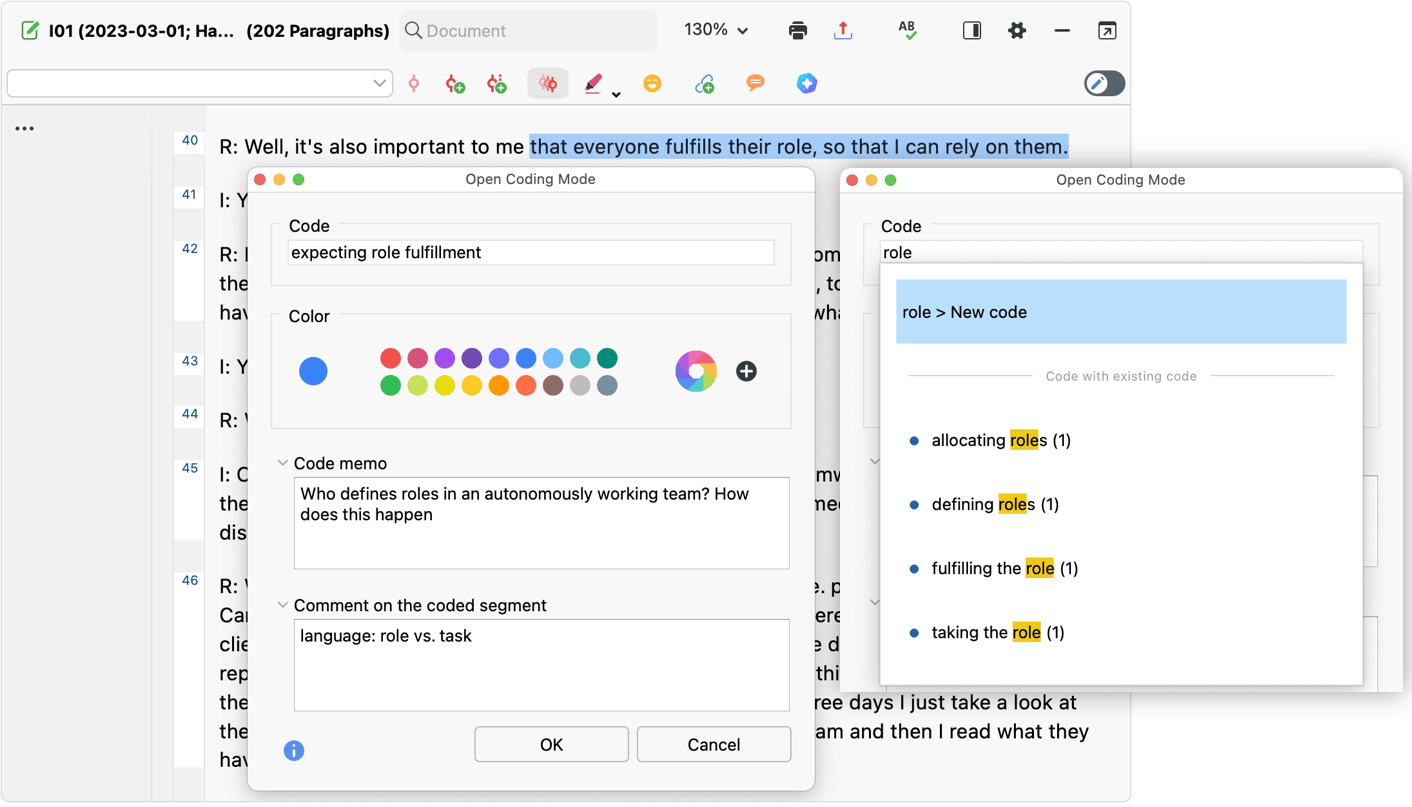
The Open Coding Mode Streamlines the Initial Coding Process in Grounded Theory
While typing a new code name, MAXQDA displays any existing codes with similar names. This helps you maintain oversight of your coding system, avoid creating duplicate codes, and easily merge similar codes when appropriate.
Tip: Receive Automatic Code Suggestions (with AI Support)
MAXQDA can even automatically generate code suggestions for phrases or text segments. When using the AI Assist add-on, you can highlight a text segment and select AI Assist > Suggest New Code for Text Selection from the right-click menu. MAXQDA then presents multiple suggestions for suitable codes, including brief explanations.
For a Grounded Theory analysis, the third section containing interpretive codes is particularly valuable:
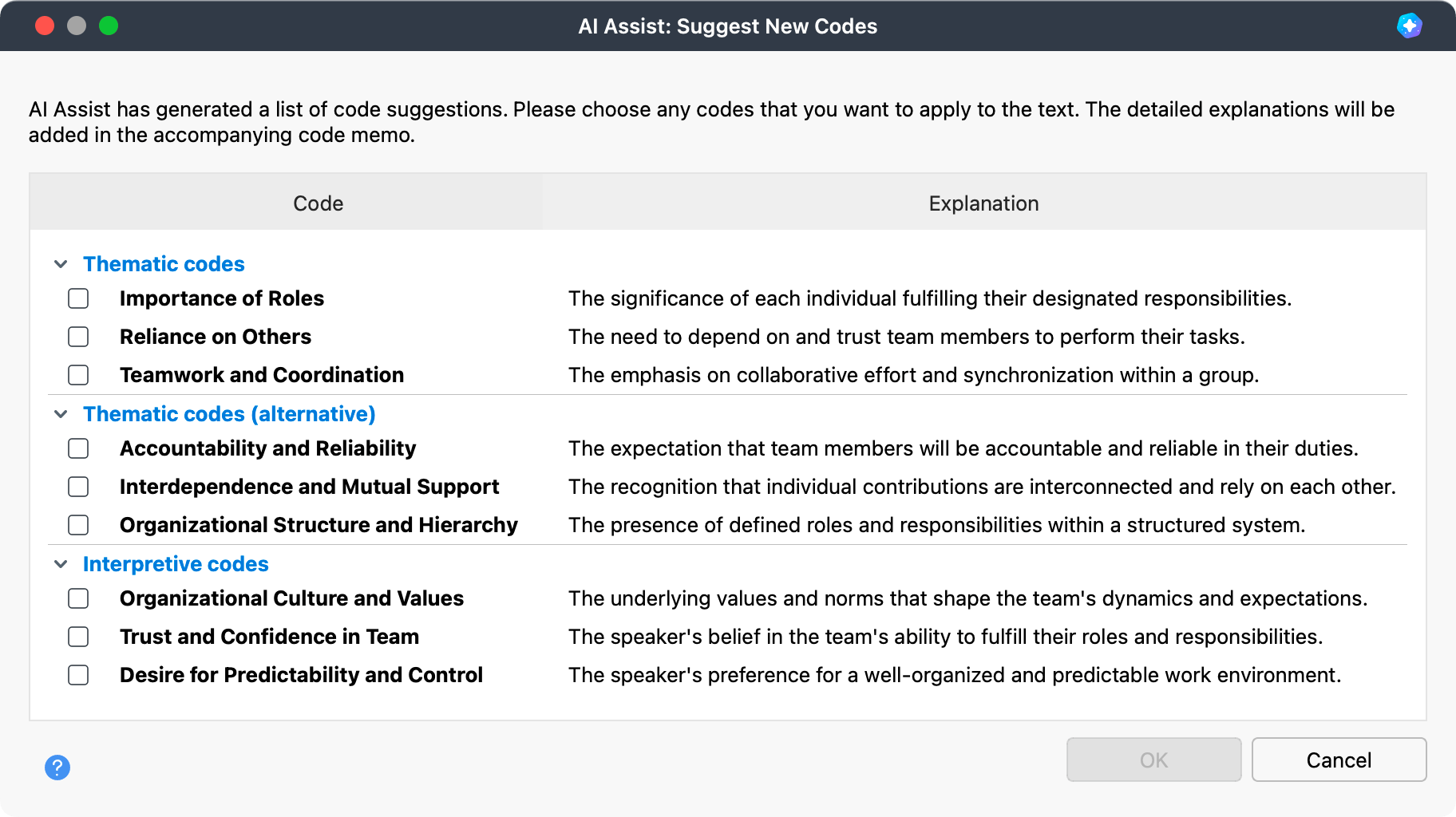
Automatically Generated Code Suggestions by MAXQDA
In-vivo Coding
When conducting open, initial coding in Grounded Theory, “in-vivo coding” plays a vital role: analytically significant words or phrases from your data material become code names themselves. This technique maintains the authenticity of your data. In MAXQDA, clicking the Code in vivo icon creates a new code at the top of your code system, adopting the highlighted text as the code name while simultaneously coding the selected passage.
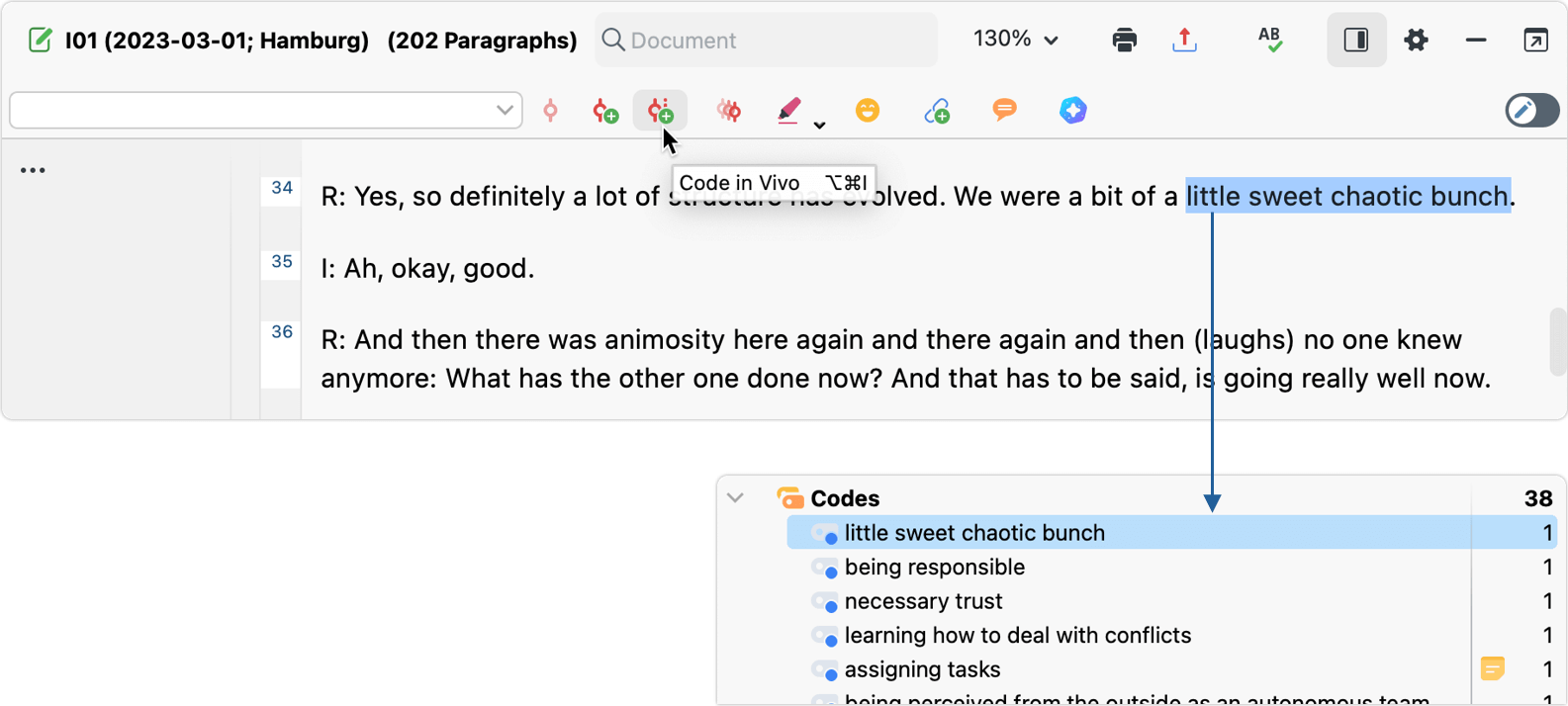
In-vivo Coding: Converting Text Segments Directly into Codes
Color Coding
Love working with highlighters? Just as you might highlight passages in a book, MAXQDA enables you to mark text segments with color coding. When you “color-mark” passages, they’re automatically coded, making it effortless to locate and compile these segments later.

Color Coding: Mark Your Text Passages as You Would with a Highlighter
Step 2 of Grounded Theory Analysis with MAXQDA: Advanced Coding
The open, initial coding phase typically generates extensive lists of preliminary codes. Once you’ve completed initial coding of your first data sets, your next challenge is to elevate the analysis to a more abstract level. This involves reviewing, analyzing, merging, and abstracting codes to develop them into categories—the fundamental building blocks of your emerging theory. Charmaz (2014) refers to this progressive coding as “focused coding,” Strauss and Corbin (1990) speak of “axial” and “selective” coding, while Glaser (1978) calls it “theoretical coding.” Whichever Grounded Theory approach you follow, MAXQDA offers powerful tools to support your advanced coding work.
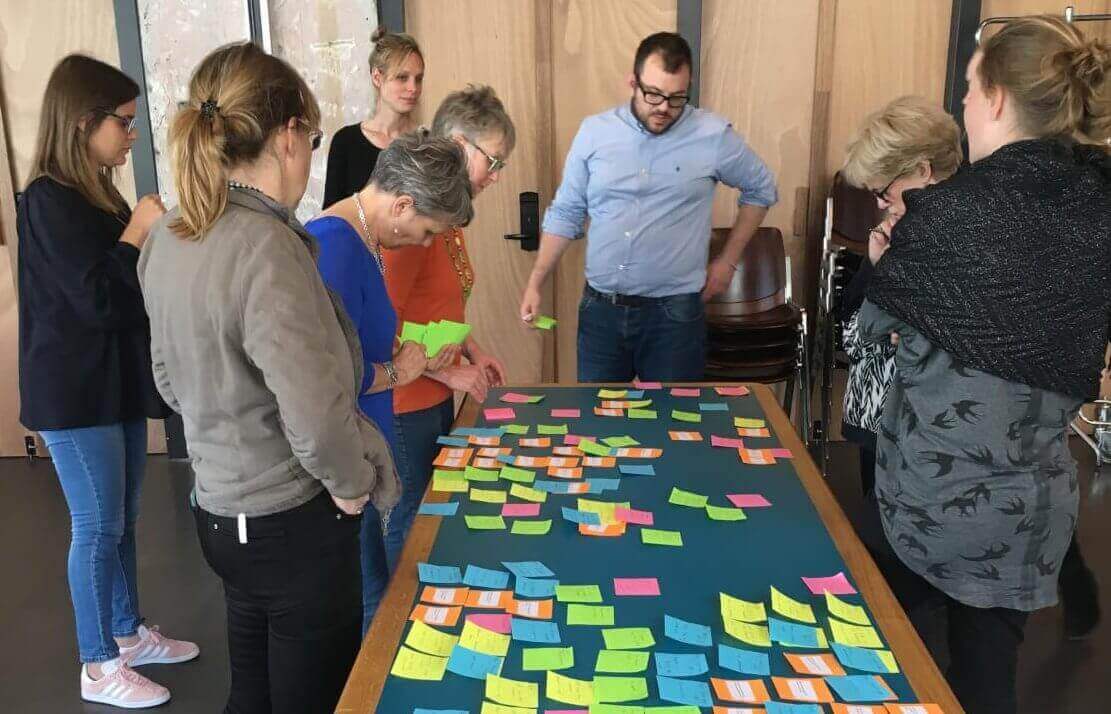
Organizing Codes
The “Codes” window allows you to structure codes into main codes and subcodes—perfect for grouping similar aspects and concepts and introducing more abstract, analytical terms. You’re not restricted to a single level of subcodes—create subcodes of subcodes as your analysis demands. The numbers displayed next to each code show how many segments in your data have been assigned to that particular code.
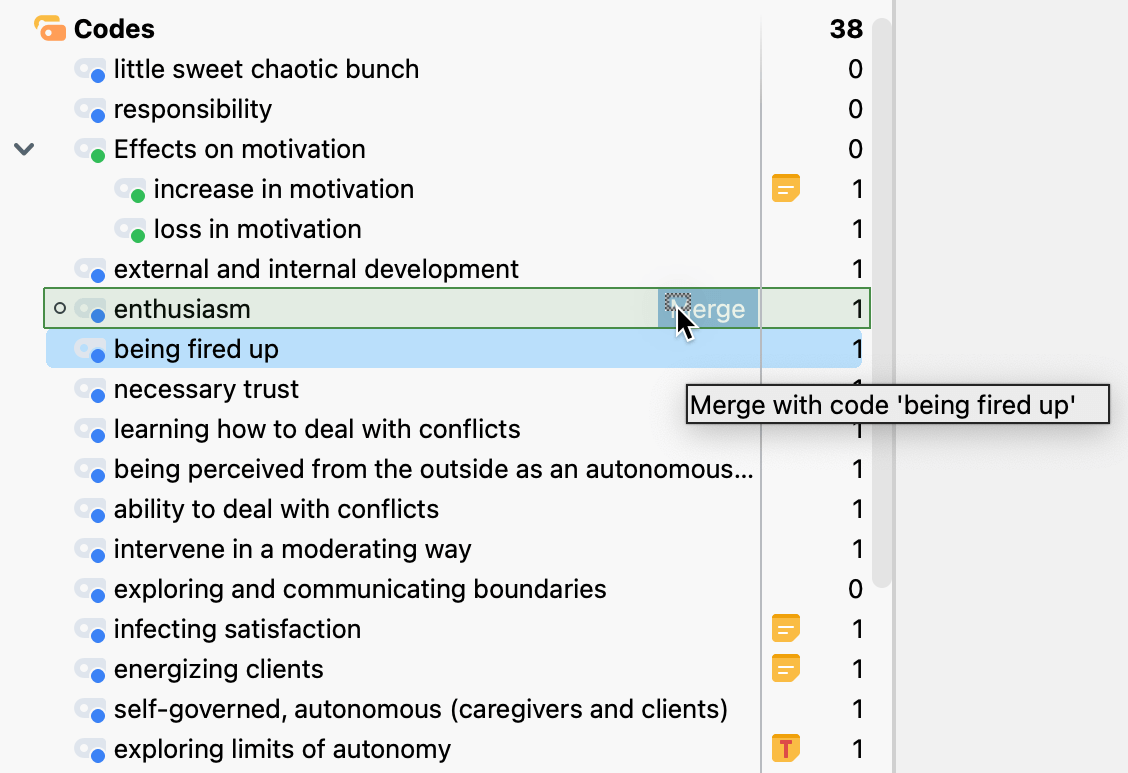
Working with Open Codes in the MAXQDA “Codes” Window
Tip: Want to combine two similar codes? Simply drag one code onto another and drop it on the “Merge” label, as illustrated in the image.
Creative Coding: Visually Organizing Codes on a Workspace
MAXQDA offers a dedicated workspace for visually working with your codes: Creative Coding. Imagine a large pinboard where you can organize your code labels just like sticky notes.
When you launch Creative Coding, a new window appears. On the left, you’ll see your current “code tree” from the “Codes” window. The empty canvas on the right is your workspace: drag codes into this space and arrange them as you would on a pinboard. Work with individual codes or bring multiple codes onto the canvas at once.
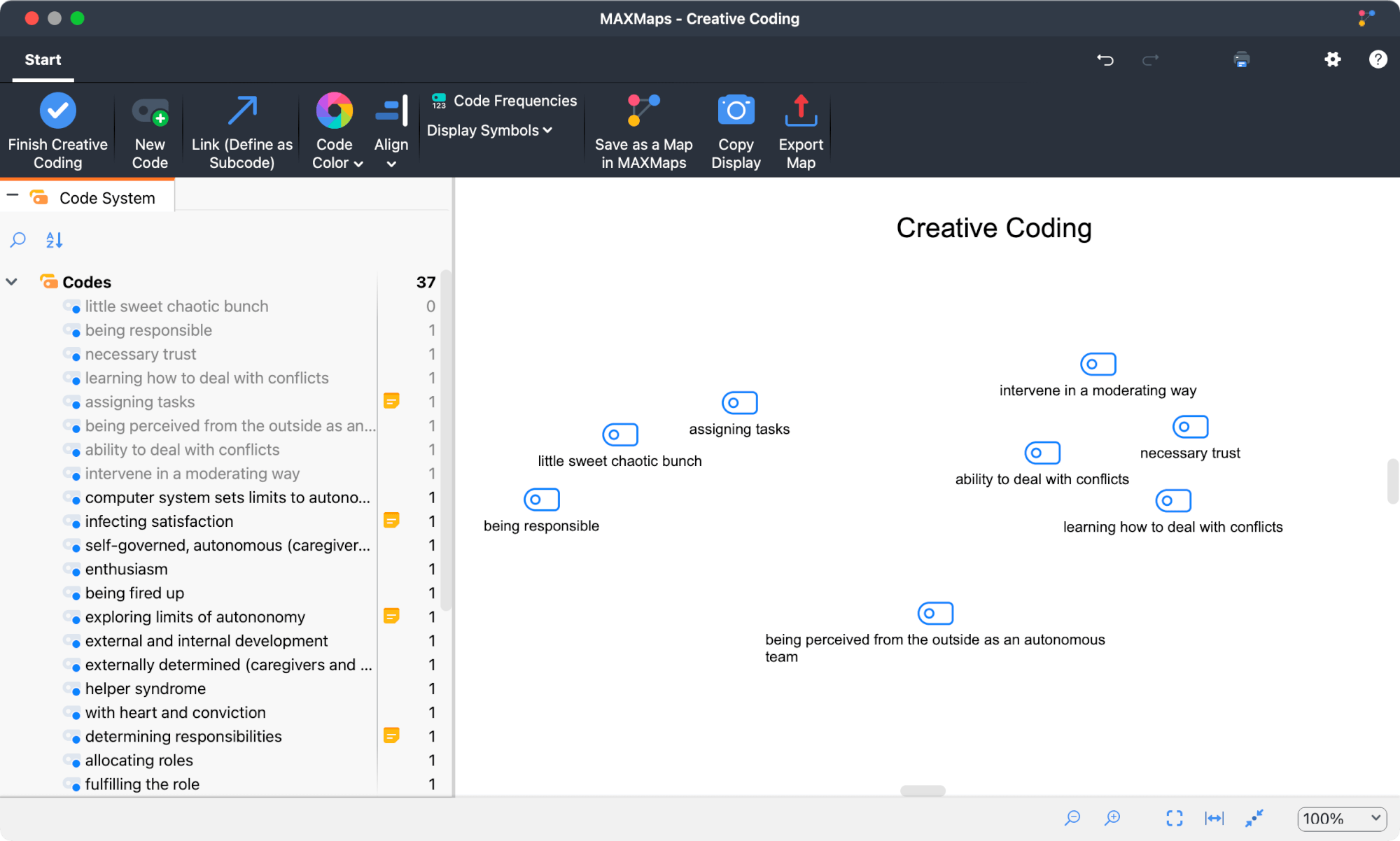
Creative Coding: Selecting Codes for Your Visual Workspace
Creative Coding empowers you with multiple ways to organize your codes:
- Arrange similar codes in proximity to each other.
- Merge codes simply by dropping one code onto another.
- Insert more abstract terms and create relationships using arrows to connect them with subcodes. As you work, these may evolve into categories, depending on their level of abstraction and theoretical significance.
- Apply different colors to individual codes and code groups to create conceptual boundaries and make similar codes instantly recognizable. These code colors appear throughout MAXQDA, serving as powerful analytical markers.
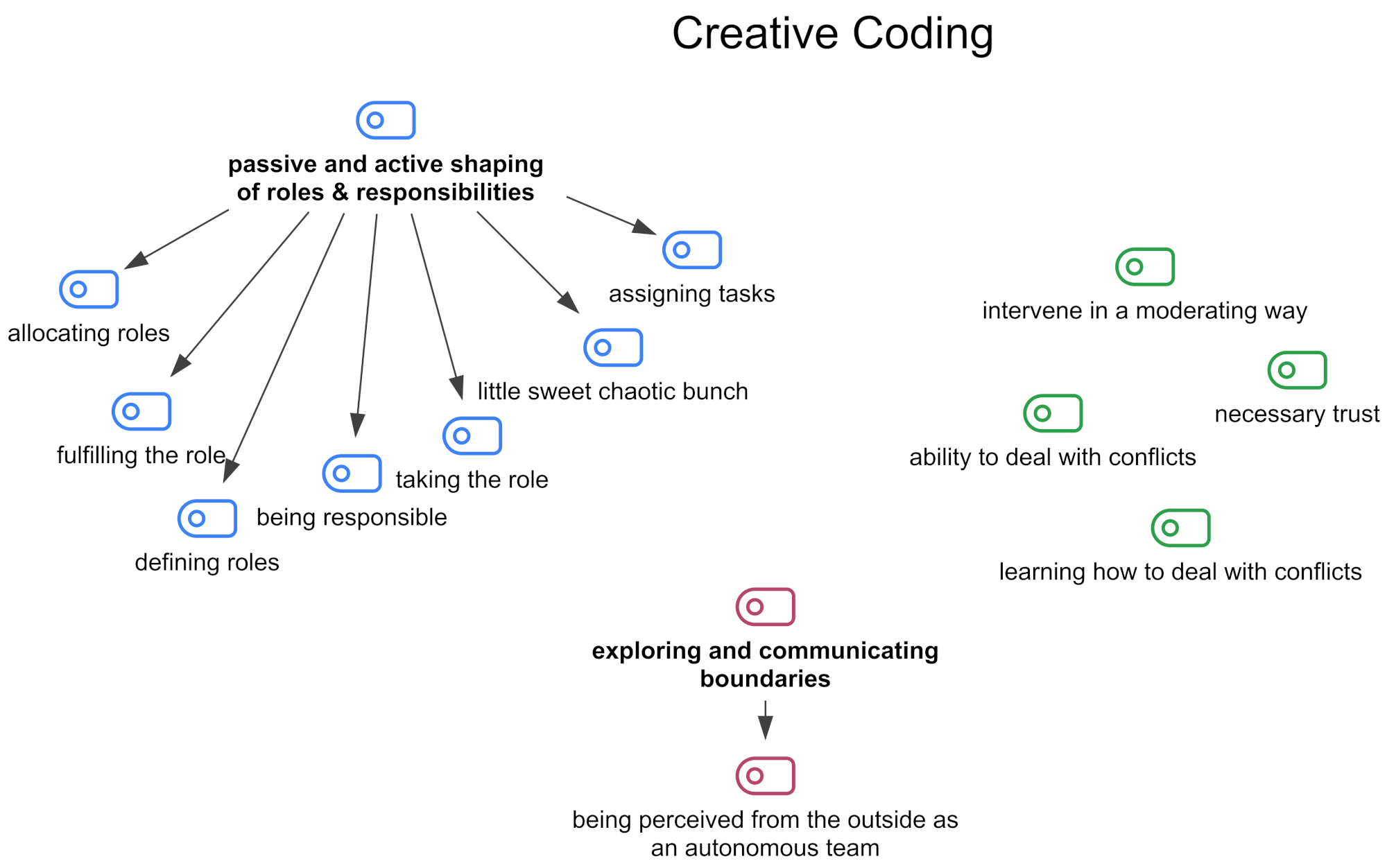
Creative Coding: Group, Structure, and Color Your Codes
Tip: Creative Coding keeps you connected to your data throughout your Grounded Theory analysis. Hover over any code symbol to reveal analytical notes from its code memo, or double-click to access all data segments assigned to that code.
When you’re ready to finish, transfer your new structure directly to the “Codes” window. MAXQDA automatically incorporates all new codes, combines merged codes, maintains your color selections, and adjusts the hierarchy according to your arrow connections.
Remember: While MAXQDA consistently uses the term “Codes,” these may actually represent “Categories” as your Grounded Theory analysis progresses.
Memos – At the Core of Grounded Theory Analysis
While coding is undoubtedly central to Grounded Theory analysis, equally crucial—and often underestimated—is the continuous practice of memo writing. Memos accompany your entire research journey and serve as the primary tool for theory development.
The researcher ‘theorizes’ from the data by writing memos to extract theoretical meaning behind codes and logical relationships between codes during the coding process. (Glaser, 1998).
As we proceed with our analytical steps, let’s first focus on this vital aspect.
Memos are written analytical records that capture your thoughts, ideas, and insights throughout the research process. They function as “conversations with yourself” about the data, as Charmaz (2014) eloquently puts it. Through memos, you document initial interpretative ideas, develop codes into theoretical categories, record research decisions, and ultimately elaborate your emerging theory.
Memos in MAXQDA
Memos in MAXQDA look like the following. Each MAXQDA memo has a title, enabling you to identify its content—making future retrieval and development straightforward. Another practical feature: You can always track when a memo was created and last modified.
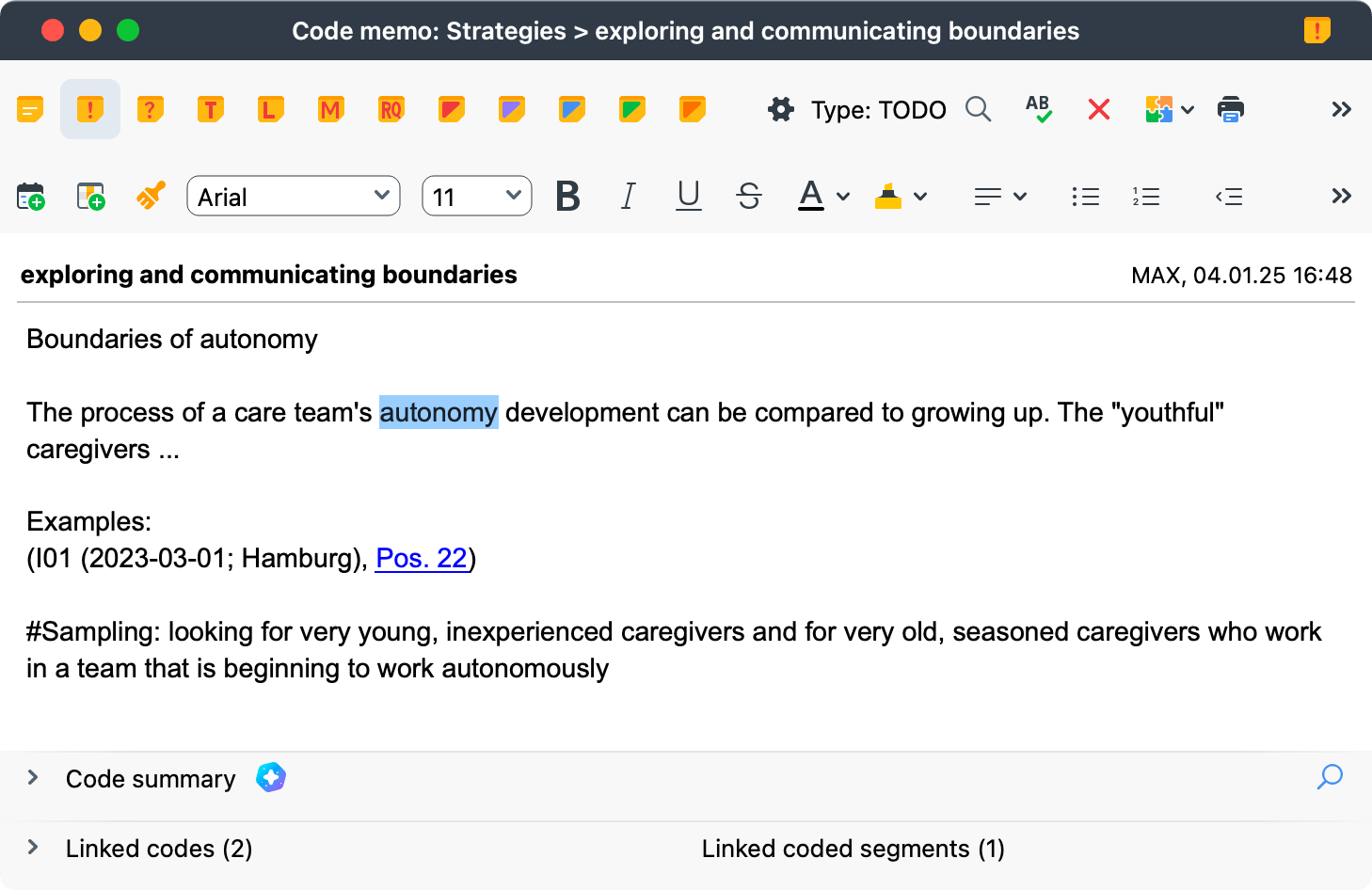
Memo for a Code in MAXQDA
In MAXQDA, you can attach memos like sticky notes to your data, codes, categories, and cases. For Grounded Theory studies, here’s how you might utilize different memo types:
- Memos within your data (In-Document Memos): Capture analytical thoughts, insights, and interpretations about specific text passages or image sections.
- Memos attached to codes (Code Memos): Record analytical insights about codes, categories, and concepts.
- Memos attached to cases/documents (Document Memos): Document supplementary information about individual cases and data collection contexts; create case summaries; record case-specific analytical insights.
MAXQDA provides additional forms of memos, including free memos that are not tied to specific elements—perfect for reflecting on assumptions, exploring overarching concepts, and integrating various analytical insights.
On MAXQDA’s interface, memos appear as small yellow sticky note icons. Simply double-click any icon to open and edit the memo.
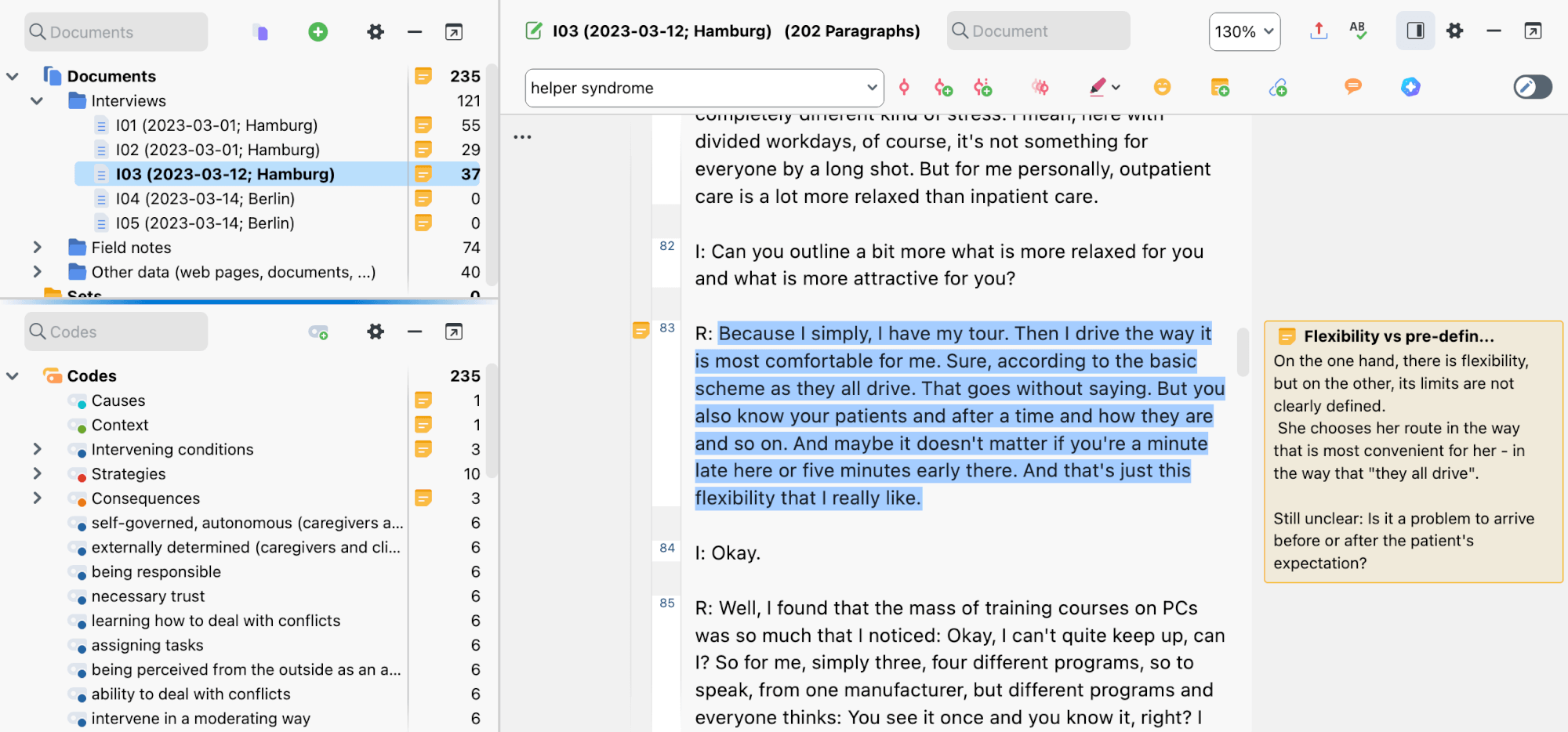
Memos in the MAXQDA Interface: Your Analytical Thoughts Accessible as Yellow Sticky Notes
Each memo can be assigned one of twelve distinct symbols—for instance, “T” for theoretical reflections and “M” for methodological decisions. You might reserve one of the colored symbols for integrative memos, which “pull together all the information a researcher has on a concept and to get a sense of how major concepts might fit together” (Corbin & Strauss, 2015). This visual system makes it effortless to distinguish between different types of memo content.

Memo Symbols: Your Visual Guide to Different Types of Memos
Tip: Define your project-specific meanings for these symbols by clicking the gear icon next to the memo symbols within a memo.
Keeping Your Memos Organized: The MAXQDA Memo Manager
MAXQDA’s Memo Manager, accessible through the “Memos” tab in the main menu, helps you maintain a clear overview of all your memos. For instance, select Memos > Code Memos to view all memos attached to your codes. In the Memo Manager, you can read, edit, filter, compile sets of related memos, and export your work.
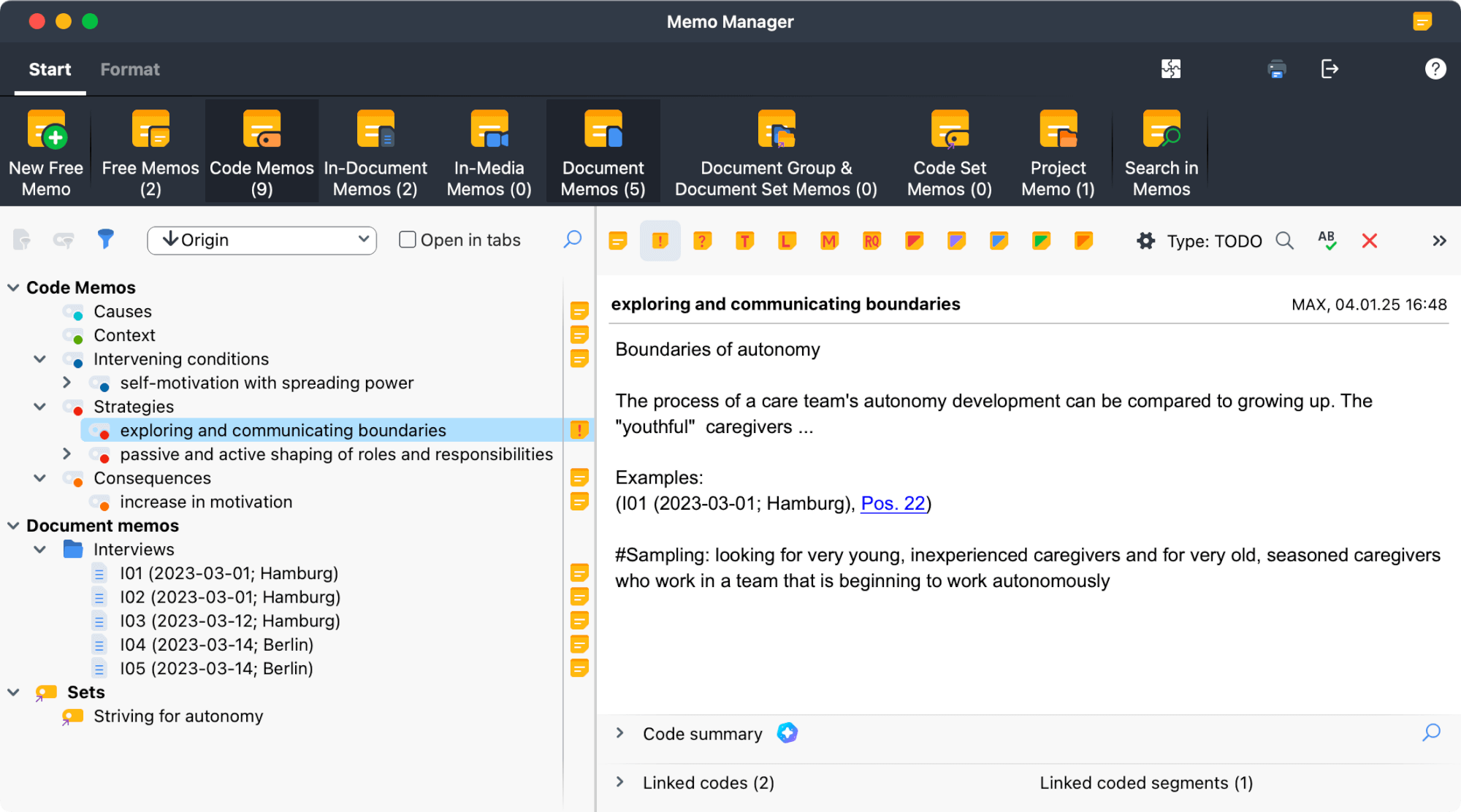
Memo Manager: Access and Edit All Your Project’s Memos at a Glance
The Memo Manager offers a powerful new way to track and develop your analytical thoughts—an essential foundation for theory development in Grounded Theory.
Step 3 of Grounded Theory Analysis with MAXQDA: Visualizing Your Theory
Through progressive coding, significant categories and theoretical relationships between these categories begin to crystallize. The initial components of your substantive theory start taking shape. If you haven’t reached this point yet—don’t worry! You can still deepen your coding work and gather additional data.
Even with just preliminary ideas about relationships: Creating a concept map of your current understanding serves as an excellent catalyst for theory development. Visualization stimulates thinking about connections and relevant conditions. Visual maps also help you spot gaps in your emerging theory, which you can then address through theoretical sampling—collecting additional data.
Diagrams are visual devices that depict relationships between analytical concepts. Corbin & Strauss (2015)
For creating concept maps, MAXQDA offers the MAXMaps workspace. Here, you can design a new concept map and bring any elements from your project onto the canvas. Your map might include specific categories, coded segments from your original data, and memos containing analytical insights. Connect elements using lines and arrows, adding meaningful labels such as “is a form of,” “is part of,” or “results in.” Enhance your visualization by adding free text fields, circles, rectangles, and other shapes to the map.
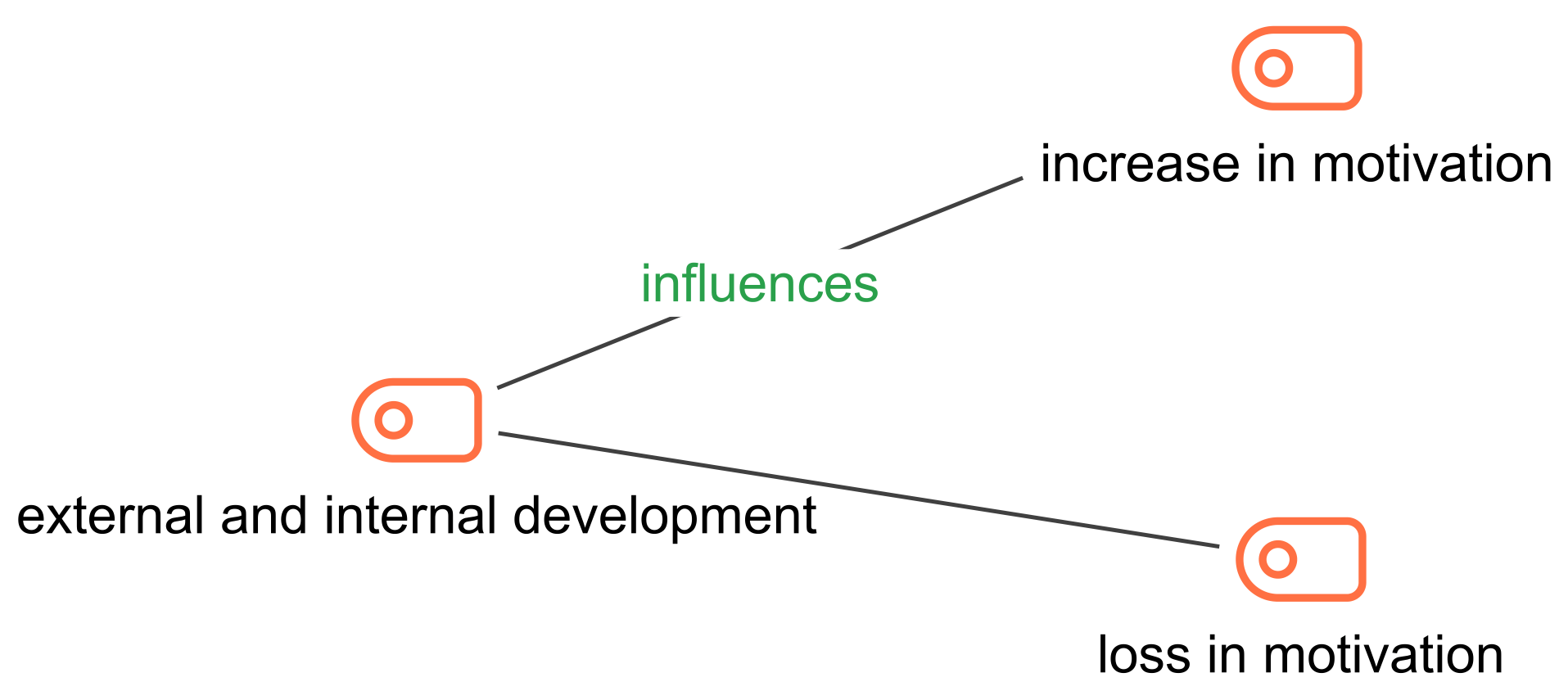
Develop concept maps to support theory development
Model Templates for Grounded Theory Diagrams
MAXMaps comes equipped with numerous model templates that automatically transform key components of your project into visual maps. You’ll find both case-based and code/category-based templates. For Grounded Theory analyses, the Code Theory Model proves particularly valuable. It visualizes a category with its subcategories alongside associated memos containing your analytical insights:
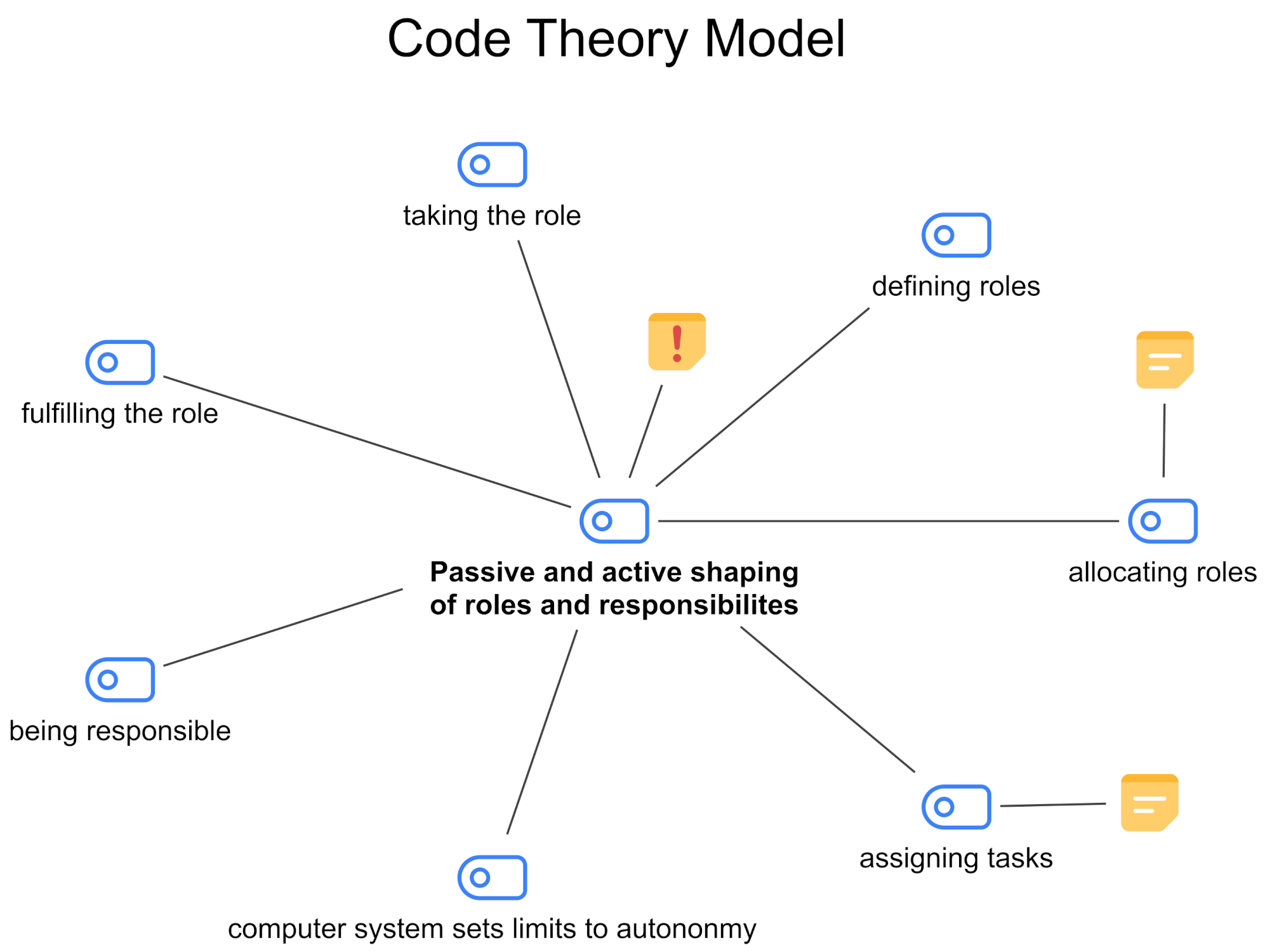
Code Theory Model: From Template to Your Customized Theoretical Framework
Just as in Creative Coding, every element in MAXMaps maintains a live connection to your MAXQDA project. Double-click any element to instantly access original data, coded segments, or analytical memos. This enables you to move fluidly between abstract theoretical relationships and their empirical foundations.
Advanced Tip: MAXMaps is well suited for implementing established Grounded Theory analytical tools, including Strauss and Corbin’s “Coding Paradigm” and “Conditional/Consequential Matrix,” as well as Clarke’s “Situational Maps.”
Step 4 of the Grounded Theory Analysis with MAXQDA: Theoretical Integration and Writing-up
Developing a grounded theory is a cyclical journey. The activities described in previous steps—coding, category development, visualization, and memo writing—are revisited multiple times. New data are analyzed following this approach, and when necessary, additional data are collected and analyzed through Theoretical Sampling. Fresh insights are woven into your emerging theory until theoretical saturation is achieved.
Then comes the greatest challenge: theoretical integration. As Corbin and Strauss (2015) emphasize: “Integration is probably the most difficult part of doing analysis because it requires sifting and sorting through all the memos and looking for clues of how the categories fit together.”
MAXQDA equips you with powerful tools to master this complex task.
The Memo Manager: Your Integration Assistant
Your theoretical memos hold the key to integration. Using the Memo Manager introduced earlier, you can compile all your theoretical memos, filter them by concepts, and systematically weave them into a coherent theory. Create additional integrative memos or transfer your insights directly into your research report as building blocks for writing up your theory. Of course, you can also export any selection of memos as a text file.
QTT: Your Theory Development Workspace
MAXQDA’s innovative QTT workspace (Questions—Themes—Theories) offers the perfect environment for synthesizing your findings. Here, you bring together all vital elements of your analysis:
- Research questions as your foundation
- Key codes and categories
- Essential memos
- Relevant quotes
- Visualizations
- Theoretical insights
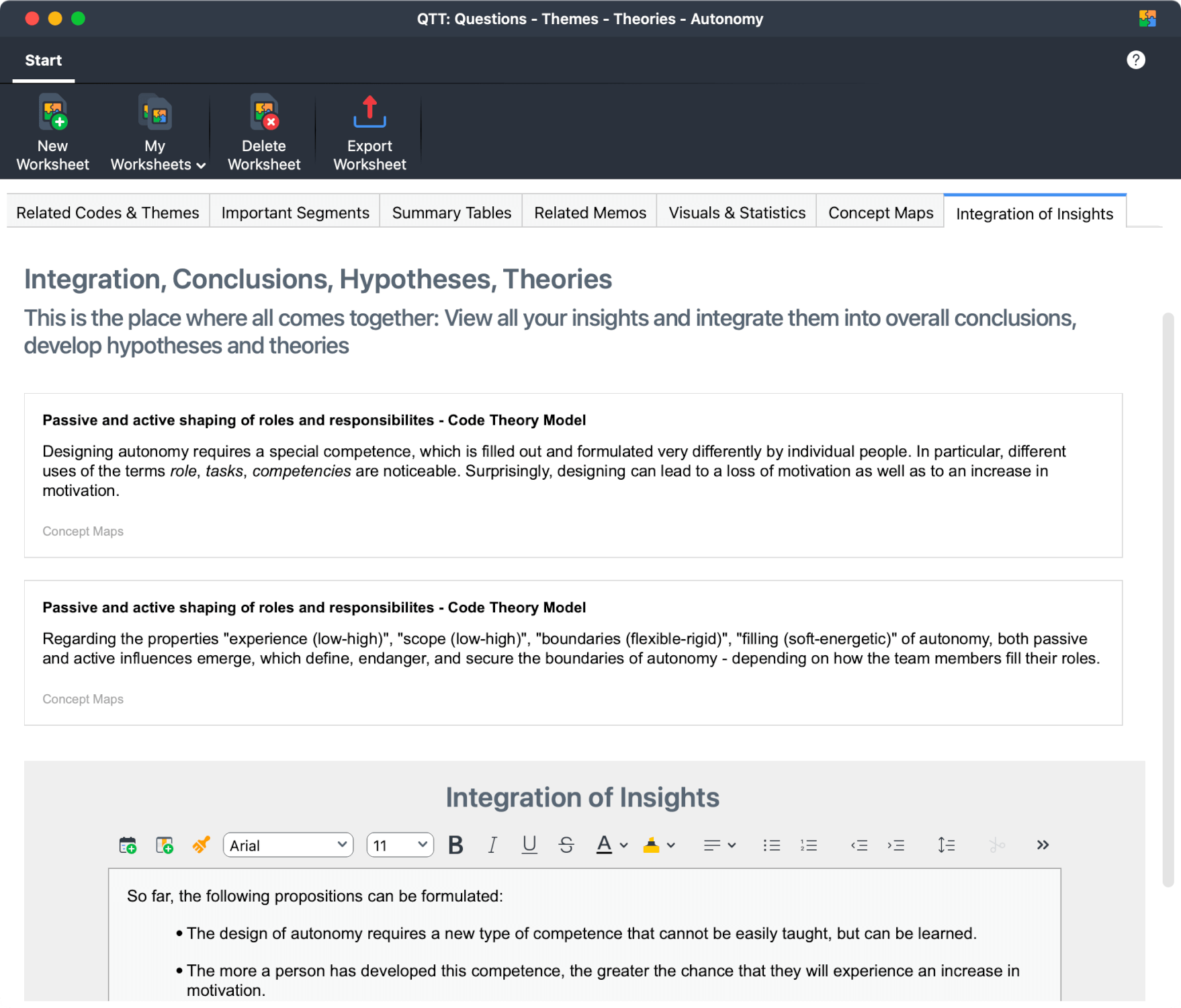
QTT Workspace: Where Your Research Insights Come Together
For every element you add to QTT, you can document your analytical insights, which automatically flow into an “Integration of Findings” section. Think of the QTT workspace as your bridge between analysis and research report. The collected insights, visualizations, and quotes provide an ideal foundation for crafting your Grounded Theory.
Tip: Set up a QTT worksheet at the beginning of the integration phase and systematically collect your key findings. This will help you maintain clarity and make the writing process much smoother.
AI Support for Your Grounded Theory Analysis in MAXQDA
Integrating artificial intelligence into qualitative data analysis opens exciting new possibilities for Grounded Theory studies. MAXQDA’s AI Assist add-on can enhance various stages of your analysis—not as a substitute for your interpretative work, but as a complementary tool to sharpen theoretical sensitivity and deepen data exploration.
In Step 1, we introduced code suggestions, but MAXQDA’s AI capabilities extend far beyond this to support your Grounded Theory project:
- Explain: Gain clarity on unfamiliar terms or technical language in your data, enriching your interpretations during open coding.
- Summarize Texts: Get quick overviews of individual texts to pinpoint relevant passages for open coding.
- Summarize Coded Segment: Explore properties and dimensions of emerging categories by synthesizing coded segments across all or selected cases.
- Chat about a Text: Uncover patterns and themes in individual interviews you might have missed, enhancing your theoretical sensitivity.
- Chat about Coded Segments: Analyze differences and similarities between cases and between “incidents” through constant comparison—a cornerstone of Grounded Theory.
Key Reminder: AI-supported features serve to spark reflection and offer fresh perspectives on your data—they don’t replace your crucial interpretative work.
We wish you every success with your Grounded Theory study using MAXQDA!
Literatur
Charmaz, K. (2006). Constructing grounded theory. SAGE.
Charmaz, K. (2014). Constructing grounded theory (2. Aufl.). SAGE.
Clarke, A. E. (2005). Situational analysis: Grounded theory after the postmodern turn. SAGE.
Corbin, J. M., & Strauss, A. L. (2015). Basics of qualitative research: Techniques and procedures for developing grounded theory (4. Aufl.). SAGE.
Glaser, B. (1998). Doing grounded theory: Issues and discussions. Sociology Press.
Glaser, B. G. (1978). Theoretical sensitivity: Advances in the methodology of grounded theory. Sociology Press.
Glaser, B. G., & Strauss, A. L. (1967). The discovery of grounded theory. Aldine.
Strauss, A. L., & Corbin, J. M. (1990). Basics of qualitative research: Grounded theory procedures and techniques. SAGE.
Strauss, A. L., & Corbin, J. M. (1998). Basics of qualitative research: Techniques and procedures for developing grounded theory (2. Aufl.). SAGE.
Further Resources for Your Grounded Theory Analysis
Free MAXQDA Press Guide
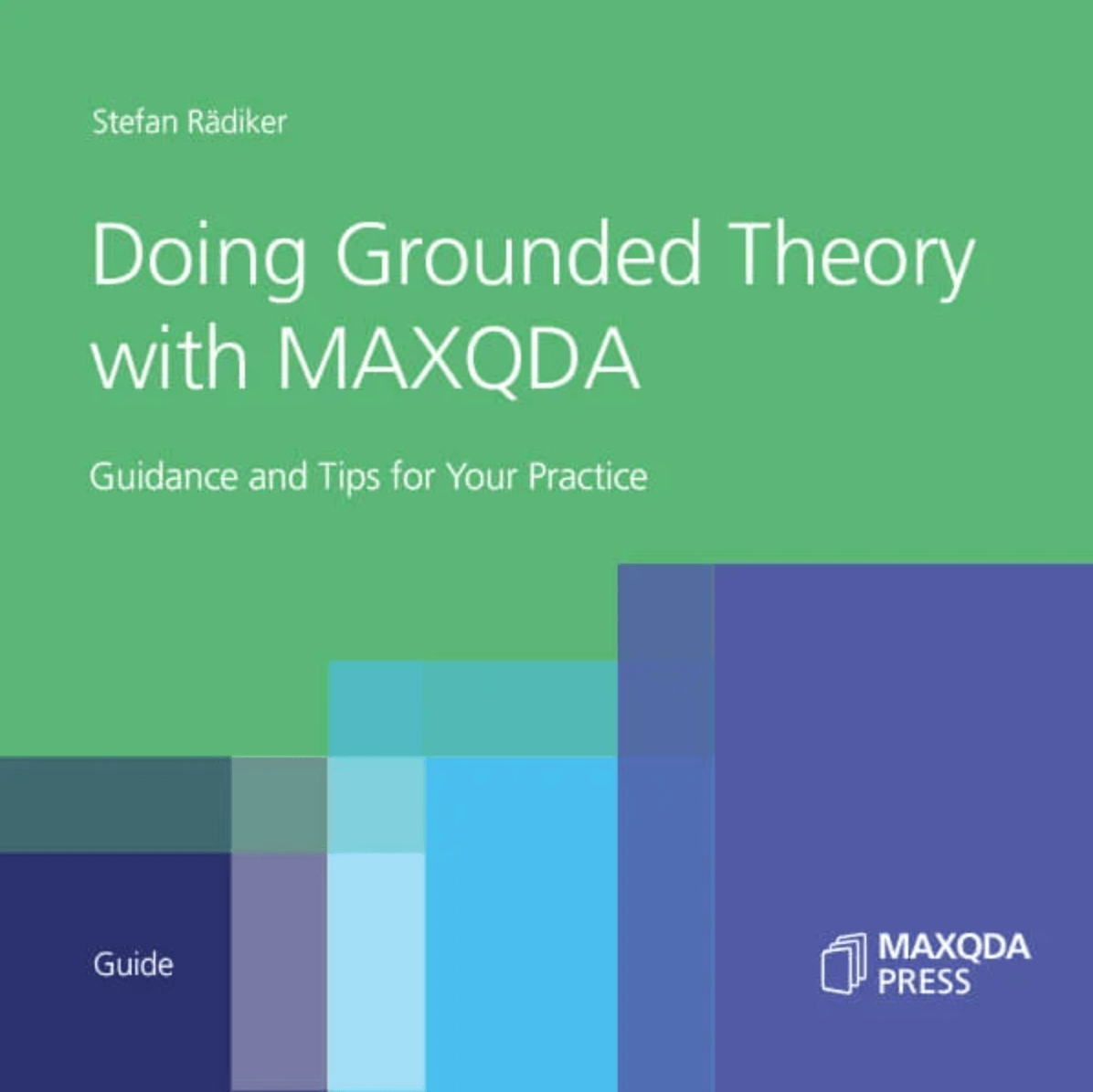
The comprehensive guide by Rädiker (2023) provides:
- Step-by-step instructions
- Rich visual examples
- Advanced methodological insights, including practical implementation of the coding paradigm (Strauss/Corbin) and coding families (Glaser) with MAXQDA
Video Tutorial (45 min.)
Discover practical tips for implementing Grounded Theory projects with MAXQDA in this video, including live demonstrations of key features.

